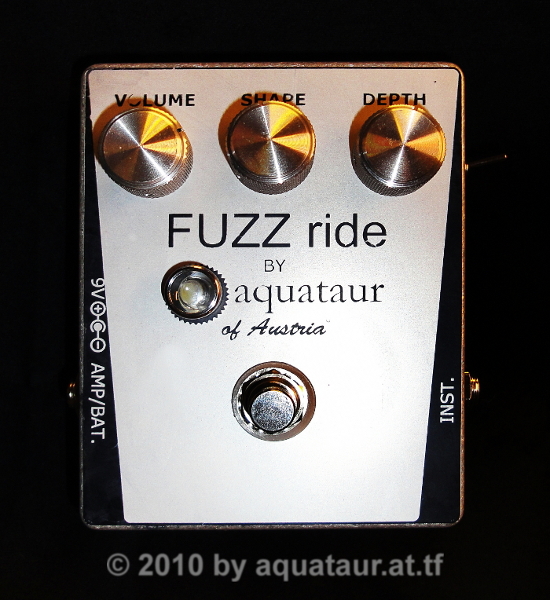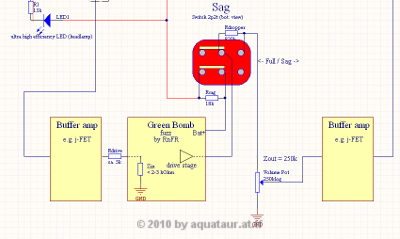|
The Fuzz Ride -
a
tribute to the Fuzz Rite©
A Fuzz Rite implementation with vintage sound but modern attributes last update: May 14, 2011 Copyright
2010-25
by H.
Gragger. All Rights Reserved. All information
provided herein is
destined for educational and D.I.Y. purposes only.
Commercial re-sale,
distribution or usage of artwork without explicit
written permission of
the author is strictly prohibited.The original
units with
their
associated trade-names are subject to the
copyright
of the individual copyright owner. The Author is
by no means affiliated
with any of those companies. References to trade
names are made for
educational purposes only.By reading the
information provided here you
agree to the Terms
of
Use. The working
language is kept in English as an aid. Read here
why.
|
||
| MAIN PAGE>MUSIC
STUFF>FUZZRIDE Index   A Typical 60ies Fuzz A Typical 60ies Fuzz  A Look At The Innards A Look At The Innards  Eliminating The Flaws Eliminating The Flaws  Adding Voltage Sag Adding Voltage Sag  Sound Samples Sound Samples   A Typical 60ies Fuzz The Fuzz Rite
is a fuzz box whose tone would be called typical
60ies – raw and fuzzy.
It is similar in construction to other contestants
of the time in so
far that the available semiconductor devices at
the time were low gain
compared to contemporary devices and circuit
designers would try to
wring the most performance out of those
transistors with appropriate
circuitry. It thus has an input stage similar to
the then ubiquitous
fuzz face and a relatively high output impedance,
meaning one
may
encounter severe problems trying to interconnect
the device with other
devices just like with a fuzz face.
People have made extensions to the Fuzz Rite, mainly Gus with his Rite Fuzz and a designer called RnFR with his Green Bomb. Also, there is a plethora of fuzzes that use a similar topology, as shown on the fuzz comparison chart on Aron Nelson´s page. Back To Index A Look At The Innards One
of the measures to exploit gain is the grounded
emitter. Since in a
common transistor voltage amplifier stage the gain
is mainly set by the
ratio of the collector resistor versus the emitter
resistor, a grounded
emitter will yield the most gain within margins.
This also will limit
the available headroom, which is why the Fuzz Rite can
sound
very gated
at some settings. From a viewpoint of fidelity, a
bad thing, from a
musicians viewpoint, maybe a good thing. As usual,
the beauty lies in
the ear of the listener.
Also, this may not work equal with all transistors, so a first improvement is to include small value emitter resistors. Also, the original had the low band pretty much restricted (a sound which must have been favored in the sixties), so the Gus Rite and Green Bomb use much bigger capacitors for extended bass. Of course, this changes the tone away from the original. A designer and forum member called RnFR has added a control that lets you sweep everything from stock grounded emitter (for the first stage at least) to a phase cancellation tone similar to the original on the other side in his Green Bomb circuit. This trick is not far from genius. One
of the drawbacks of the input transistor stage
used is the very small
input
impedance, similar to a fuzz face. There are
only a few kOhms one could
expect. Like in a fuzz face, this leads to a
radical cleanup action
when the guitar´s volume is turned down,
subjectively even more
dramatic than with a fuzz face, almost like a
on-off switch. Well, it
turned out some people like that, but an
impedance mismatch is always
prone to invite trouble with preceding and
succeeding devices.
Impedance
needs to be
matched properly, so this case calls for
buffering.
Also, the „fuzz“ control in a Fuzz Rite architecture differs significantly from other fuzz box topologies in that it does not change the amount of signal that hits a subsequent stage (like in a classical tube amp). Most contemporary fuzz boxes have an „amp-style“ gain control that sets the amount of signal going into the device and an output volume control to compensate the volume increase, while the overall gain is usually kept unity. The guitar´s volume and the fuzz control are somehow interacting (one of those fuzz boxes is the Boss Tone). The Fuzz Rite architecture does of course provide some fuzz adjustment, but it rather blends the signals coming from two amplification stages, the one in front and one that is daisy-chained to the first (out of phase), and with a volume increase towards second stage settings. This architecture leads to a wide range of tonal possibilities from very gated over octave effects to fully nasty distortion, which other fuzz boxes cannot produce. Very versatile, if one likes the basic tone. But it stems from the very same topology, that the guitar´s volume control is the only way of changing the amount of signal that hits the first gain stage. It is therefore of prime importance, to have a good working volume control, one with more than an on-off-action. The (input) buffer does away with that problem, without changing the overall tone. The theory behind that has been explained at length in my Poker Face article. Back To Index Eliminating The Flaws So, yes, the Fuzz Rite is
a
good design. But it can be augmented.
I buffered the thing, as I have layed it out in my Poker Face article. What was called the „fuller mod“ on a fuzz face, namely a series resistance that creates some sort of current drive on the input, also works on the given topology. One may indeed want to make this variable, but I decided to make it fixed. Too many knobs. I chose a 5k resistor in series, which does not drop the voltage significantly and simulates the impedance of a single coil drive. The tone remains unchanged by this measure, as A/B comparison shows. Also, a 250k Pot on the output is not exactly low-impedance, so the output got buffered as well. The output buffer will eliminate tone-sucking due to long cables and drive problems possibly caused by subsequent devices and does not contribute significantly to battery current consumption. The "on"-LED by the way is comprised of the usual ultra high efficiency LED out of a defunct head-lamp in combination with a 15k series resistor for ultra-low current demands one could only have dreamt of just a few years ago. A lens bezel helps to disperse the somewhat pointed beam. Back To Index Adding Voltage Sag If misbiasing makes happy, one might as well try to drop the supply voltage to encourage this even more. Interestingly, the tone does not get more gated or farty by dropping the supply, it gets milder - the gain drops! I settled for a resistor of 18 kOhms in series with the battery. Since switching between full/sag power invariably produces a volume step, this needs to be compensated. I installed a 820 kOhm resistor in series with the volume pot (on the "hot" side) that gets bridged when the sag resistor is in place via a DPDT toggle switch. You may need to play with that probably. The overall volume is of course reduced by this measure, but for my taste there is still enough reserve. If someone wants the full volume, play with the balance of those two resistors or simply don´t implement this mod at all. Listen to the sound samples and determine for yourself, if this is worth the extra effort. (coming soon...) Back To Index Sound Samples A few basic sound samples can be found in the stompbox gallery. The subsequent recordings have been done using the following setup:
(Names may be
copyrighted by the
associated copyright holder)
Note that I have made recordings with full and reduced guitar volume to see how the pedal cleans up. It does indeed, particularly with the reduced supply voltage. Also note the change in character with different shape and depth settings. The noise you may hear in silent passages comes from the single coils, not the pedal. Back To Index Update History
MAIN PAGE>MUSIC STUFF>FUZZRIDE |
||
MAIN PAGE
| MUSIC STUFF | IMPRESSUM  (c) 2010-25 AQUATAUR Musik & Elektronik |

